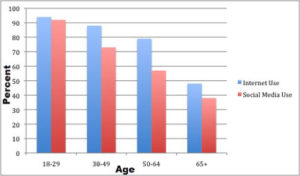These days, it’s impossible to ignore the impact of social media and the Internet, and the club industry is no exception. Recently, NCA has been taking a close look at the use of social media at clubs, generational differences in technology use, and the use of social media and the Internet among affluents. Below is a snapshot of where we’re headed in terms of the mobile web and social media broken down by affluence and by age.
For an in depth report on social media for private clubs, including best practices, be sure to read the summer Club Director, which focuses on technology of today and tomorrow. We share our recommendations for using social media successfully, including how to utilize various platforms without jeopardizing a club’s private status.
The Internet & Affluents
The significant overlap between affluent consumers, the 21 percent of households with a combined annual income of $100,000 or more, and social media users is undeniable. Affluent consumers make up 70 percent of American consumer wealth, and according to a September 2011 study by Ipsos Mendlsohn, they are the heaviest users of digital media of any economic segment in the U.S. market. It follows then, that social media and the mobile web will likely be making their way into our country’s private clubs.
Affluents spend a considerable amount of time online and as one would guess, it varies by generation. Affluent Millennials (ages 18-29) spend the most time on the Internet at close to 40 hours per week; Gen X (ages 30-44) clock in at about 35 hours per week; Boomers (ages 45-64) spend about 28 hours online; and the Matures (65+) are on the least, at 18 hours per week. (Source: Ipsos Mendlsohn, September 2011)
When it comes to social media, affluents making $200K-$500K prefer Facebook (68%) to LinkedIn (42%) or Twitter (23%). Affluents making more than $500K also use Facebook the most (72%), LinkedIn second (41%) and Twitter third (36%). (Source: Affluence Collaborative Survey, April 2011)
The Internet & Age
Most people have come to terms with the fact that social media is a big part of how younger generations not only spend their leisure time, but also how they connect with friends, family, colleagues and peers to organize, plan and decide on their activities. Clubs need to appeal to the next generation of members in order to be successful in years to come, and social media will likely play an integral part in any young member’s life.
What clubs may not be aware of—or at least be somewhat reluctant to believe—is that social media isn’t just a thing of the next generation. Its use is widespread throughout older generations, as well.
The following chart displays Internet and social media use by age. (Source: Pew Internet & American Life Project, February 2012)

While it may not be surprising that almost everyone—regardless of their age—spends significant time on the Internet, what clubs may find surprising is the extent to which people access the Web on the go.
Mobile technology is on the rise. As of May 2011, approximately 35 percent of U.S. cell phone users owned smart phones, and that number jumped to 53 percent as of March 2012, a recent Pew survey reported. Among adults, that portion is still as high as 46 percent, and, when looking at affluent adults, it increases to 61 percent.
Internet-ready technology is so prevalent that recent data from the NPD Group shows that there are more web-connected devices in this country than people (about 425 million Internet-connected devices for a population of only 315 million).
Neilson’s Social Media Report 2012 indicates that mobile and app traffic increased significantly for all social networks, too. Facebook had 88 percent more visitors from mobile apps—specifically downloaded applications for mobile devices—while mobile Web visitors were up 85 percent. Twitter’s mobile-based app visitors increased 134 percent, while mobile web visits increased by 140 percent. No social network saw its mobile traffic fall. Regardless of access point, people spent more time on social networks in 2013 than they did on any other website genre, which translates to a total of 20 percent of their Internet time on laptops or PCs and 30 percent of their time on mobile devices.
Now that people can literally carry the Web in their pockets, social media is moving to the top of the communications food chain. Affluents—key private club members and prospects—are increasingly turning to social media as a means to communicate with their peers. Be sure to read the summer Club Director to make sure you are prepared for the social, mobile road ahead.
![]()


